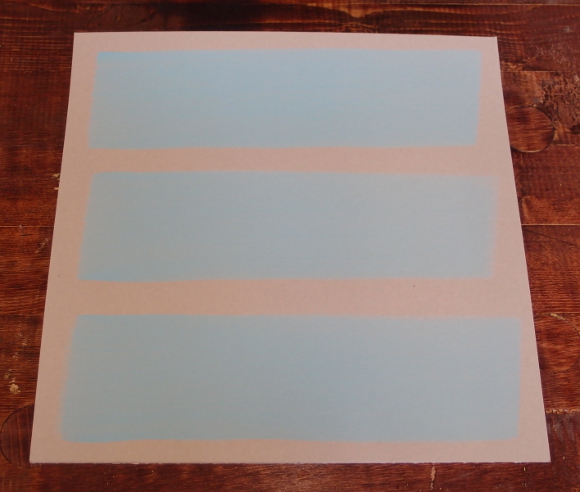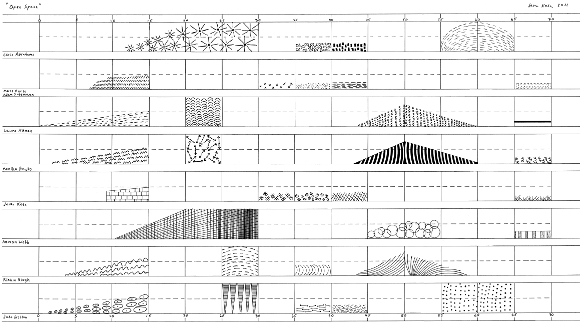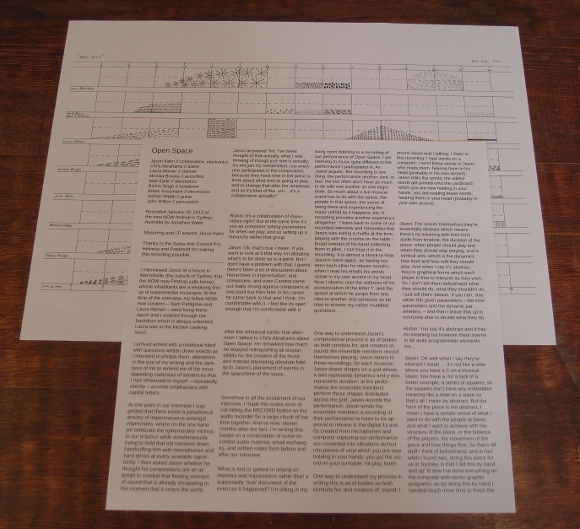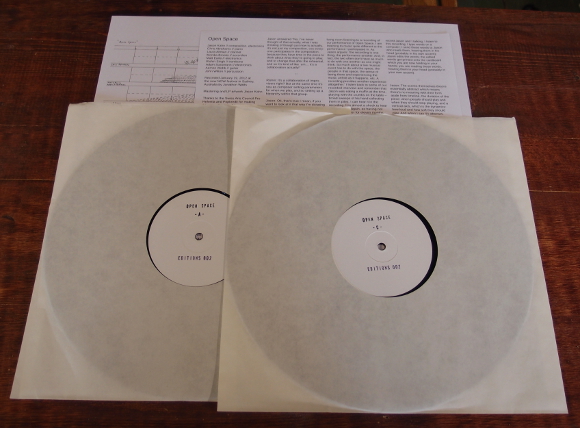
Jason Kahn
Edition of 250
Jason Kahn // composition, electronics
Recorded January 19, 2012 at Cover artwork, mix and mastering by Jason Kahn.
LP liner notes by Rishin Singh.
Side A: 15:00 / Side B: 19:00
click on score to enlarge
Excerpt Side A
The question has been posed several times, "But why do this? Why not just let the group improvise freely?" Im interested in when a playing situation becomes unstable, when the players find themselves in situations which test the comfort zone of how and with whom they want to play with. The scores serve as a conduit for this process. But they are also more: they allow me to shape a playing environment, taking into account the different players, their instruments, even the notion of the playing space itself as one of the more decisive factors in the outcome of a piece. Beyond all this, as a visual artist Im fascinated with the process of the graphical representation of sound: how we can depict a certain sound or way of playing graphically and how others can interpret a graphical form as a sound. Two parameters govern the scores: the vertical axis indicates the general dynamics of the playing, the horizontal axis is a time line. I draw graphical forms for the musicians to interpret as they wish. I only ask that all dynamic and timing indications be adhered to as closely as possible. I give no information on how the graphical forms should be reacted to. "Open Space" was commissioned by the 2012 now NOW Festival in Sydney, Australia. I chose some of the players myself, and some were suggested to me by the groups trombonist Rishin Singh (who also wrote the liner note to the LP). For the people suggested to me, and for whose work I was not familiar with, recordings were sent to me of them playing. On the basis of these recordings and my own personal knowledge of the other players, I was able to construct the score. I also knew that I wanted to work with a large group because the space we would be performing in would be a large one (which Id already played in at the 2011 now NOW Festival). The title "Open Space" refers both to the idea of working in an open space: the physical space of a room as well as the spaces of player interaction within the group and in reaction to the performance space itself; and to the notion of opening that space between improvisation and composition, delving into the friction and conduction which lie between these two approaches and opening this space up to discover the possibilities which lie therein.
Depending on how you look at it, this release might seem to be totally wrong for vinyl. It involves a single continuous performance, roughly an hour in length, much of which is conducted at low volume; sounds like a natural for a CD, right? But Jason Kahn has been down that path, and he knows what happens to those CDs. A few partisan writers (yeah, I'm one of them) will notice and write about it, a few people will buy them at shows, a few more will pirate the thing online and park it forgotten in a hard drive, and a few hundred discs will sit in a box in someone's closet. Such is the fate of minimal music made by non-stars in the 21stcentury. CDs may be sensible playback media, but they don't make much commercial sense. So the artist could just skip the trouble and expense and put the thing up on line, which is a strategy Kahn has sometimes pursued, but if you make it all free, who's going to think it's worth anything? Part of the task of the artist -- nay, any human being -- is to assert your own worth. If you say your own work is worth nothing, what will that do to your soul? I have no answers here, I'm just asking, but that leads to why a record like this comes to be on vinyl.
Was fuer ein Pfund, 2 x 180 g in dickem grauem Karton, handbemalt im sublimen Stil Rothkos. Trnasportiert wird so die Auffuehrung einer grafischen Partitur von Kahn im Januar 2012 beim nowNOW Festival in Sidney. Ein 9-koepfiges Ensemble vertiefte sich in die Herausforderung, Kahns 70-min. Komposition darzubieten: Chris Abrahams - Piano, Laura Altman - Klarinettte, Monika Brooks - Akkordion, Rishin Singh - Posaune, Aemon Webb - Gitarre, John Wilton - Percussion, Matt Earle, Adam Sussmann und Kahn selbst - electronics. Da Kahn jeder Stimme 5-, 10-, 15- und sogar 20-min. Pausen vorgibt, bleibt das Klangbild transparent. Nur von 15' bis 20' soll das Nonett tutti aufrauschen. De ralative simplen grafischen Vorgaben -- kleine Striche, Wellen, Bogen, Gitter. Sternchen, Punkte, Kringel, Kaestchen oder Kreise, angeordnet auf einer x-Achse fuer die Dauer und ein y-Ahse fuer das Volumen -- vertrauen auf die Imagination der Mitspieler, ihren Spielraum gleihzeitig eigenkreativ und zweckdienlich auszuschoepfen, wobbei jeder bis zu fuenf verschiedene Zeichen umzusetzen hat. Statt polyzentrisscher und intuitiver Interaktion wie bei der Freien Improvisation, entfaltet sich eine 8-spurige Linearitaet aus parallel rangierenden Stimmen, in der Regel vier, wenn auch von Zeitzone jeweils andere. Die Gleihmaessigkeit der Zeihen legt repetitive monotone oder Haltetoene nahe, die an- oder abschewellen bis zum rein elektronischen Pianissimo von 30' bis 39'. So entsteht ein minimalistischer Flow aus trillernden, tropfenden oder getupften, aus cchimmernden oder gefauchten Toenen, deren Tempo und Tonhoehe jeder Spieler selbst bestimmt (allerdings als 'passend' fuer eine Aesthetik, fuer di zuerst einmal nur der Name Kahn steht - der wiederum stillschweigend fuer minimale und monochrome Massstabsveraenderung steht). Anstelle von Expression bilden sich Muster wechselnder Dichte und Fuelle. Kanh nennt ausdruecklich die Beuyssche Idee der Sozialen Plastik als Inspiration fuer diese konzertierte Aktion, die mit ihrem Regelwwerk aus Jetzt und Jetzt nicht und ihren abgegrenzten Freiraeumen ja durchaus einem sozialen Modell aehnelt.
Den amerikanske musikern Jason Kahn bor i Zürich och verkar i hela världen. Detta är ett verk, Open Space, skapat för Now-festivalen i Sydney i fjor. Fyra kompositioner, där grafiska partitur leder musikerna. Dynamiken och tidsutsträckningen verkar vara gällande parametrar. Han har skrivit inte bara för olika instrument men även för olika individer.
Adepte d'une noise music où les discrétions volumiques jouent à saute-mouton par-dessus les percussions, qu'il soit en solo ou en formation, Jason Kahn trace sur son nouveau "Open Space" (Editions) une voie qu'emprunte avec autant de retenue un Gilles Aubry. Entouré de huit musiciens, dont certains à l'apport microscopique, le quinqua américain installé en Suisse continue d'élaborer sur un fil extrêmement ténu une trame blanchâtre des plus élégantes.
Ce disque de Jason Kahn est peut-être sorti sous son propre nom mais il a nécessité l'apport de nombreux musiciens. Oeuvre de commande pour le festival australien nowNOW, cette composition graphique a eu besoin du concours de musiciens comme Chris Abrahams, Adam Sussman, Monika Brooks, Matt Earle, Rishin Singh et le Stasis Duo. Malgré cette présence en nombre, c'est bien Jason Kahn qui fait le plus gros du travail. Il reste donc l'élément central de Open Space et les autres musiciens ne sont que des intervenants plus ou moins épisodiques. Cet espace ouvert donne libre court à tous les étirements possibles, aux distorsions et développements qui ici tiennent de l'abstraction mêlé a du lo-fi plus ou moins mystique et chamanique. Pièce d'un seul tenant (ce qui est difficile à voir puisque Open Space n'est disponible qu'en double vinyle et, par conséquent, fractionné) de plus d'une heure, Jason Kahn et ses camarades offrent de multiples ouvertures dont il est aisé de prendre le temps afin de les apprécier. Et cela est préférable car Open Space n'est toujours d'une écoute facile et peut facilement donner l'impression d'un ensemble désordonné et trop hermétique. Rien n'est moins faux avec ce disque qui multiplie les environnements sonores, les fait évoluer, les transforme dans des structures musicales plus ou moins hostiles et qui sont en perpétuel mouvement. Mais qui dit mouvement ne dit pas forcément rapidité. Ce mouvement est lent, complexe, difficile voire laborieux mais jamais inintéressant. Reste que ce Open Space n'est pas l'oeuvre la plus passionnante de Jason Kahn. On ne dira pas non plus que ce disque est inutile. A bien des égards Open Space est plus que satisfaisant mais on reconnaîtra également que Jason Kahn est déjà allé plus loin. Il n'y a donc pas vraiment de déception mais il n'y aura pas non plus d'emballement intempestif.
Due lp racchiusi in una confezione che sembra un quadro di Paul Klee sono quanto di meglio possa suggerire il contenuto del nuovo incredibile lavoro del compositore americano Jason Kahn. Come chiarisce il diretto interessato nelle note che accompagno la pubblicazione del disco, il suo modo di scrivere la musica utilizzando segni e simboli non si ferma a rappresentare gli strumenti ma anche i musicisti che li suoneranno. Nel caso di Open Space una piccola orchestra di nove elementi a dividersi strumenti a corda, pianoforte e percussioni di ogni tipo. Il grafico delle annotazioni musicali è un labirinto di mondi possibili. ILLUMINANTE.
Jason Kahn (composizione ed elettronica) con Chris Abrahams (piano), Laura Altman (clarinette), Monika Brooks (fisarmonica), Matt Earle (elettronica), Rishin Singh (trombone), Adam Sussmann (eletronnica), Aemon Webb (chitarra) e John Wilton (percussioni). Ma non tragga in inganno la formazione molto nutrita perche le presenze sono fanttasmatische a dir poco; tutto e all'insegna del suono piu minimo e discreto. Accordi di chitarra, flebili filamenti d'elettroniche, vaghi sbuffi di fiati, un piano che rintocca ogni molti secondi, un breve rotolio di percussioni (la side 2); un piano che soliloquia in lungo mentrre a lato soffia la fisarmonica e si aggrovigliano come serpenti al sole l'elettronica e le scale sinuose della chitarra (la side 4, la migliore). E una musica ampia e aperta, molto poetica e riservata, introversa quanto basta a comunicare sentimenti intensamente demode. Mi ha ricordato l'ormai storico "Duos for Doris" di keith Rowe e John Tilbury, ed e il miglior complimento che potrei fare a queesto disco stampato in 250 sole preziose copie.
I already spoke about the distinctive concept of composition by American Zurich-based musician Jason Kahn on the occasion of his release "Sin Asunto" for the appreciated Portuguese label Creative Sources, which involved four musicians in the musical translation of Kahn's graphical scores that "hover in the gray region between composition and improvisation" in Kahn's words. Some aspects could draw a possible analogy with Cage's aleatory music principles, but Kahn prefers to move on the threshold between free improvisation - as players can decide the way of translating graphic forms - and a set of rules for choral dynamics: his graphical scores are based on two parameters, time and intensity, which have been drwn on horizontal and vertical axes respectively. This sort of scaly time-line is the only permanent feature, whereas the composer put the interpretation of hyphens, clouds, swirls, crosses, circles, triangles, vectors and other symbols in the hands of each performers, who just know when to play and the intensity level on respective task time without knowing anything about the juxtaposition by other performers. Compared to the above-mentioned "Sin Asunto", Kahn conducts more elements (nine players including himself, the appreciated Australian pianist Chris Abrahams, Laura Altman's clarinet, Monika Brooks' accordion, Aemon Webb's guitar, Rishin Singh's trombone, John Wilton's percussions and electronics by Adam Sussmann and Matt Earle) on "Open Space", which got commissioned and performed on January 19th, 2012 at the now NOW festival in Sidney, so that the way the score inclunces dynamics is even more engaging, even if a large number of players came under request of Jason himself due to the fact he had to perform in a larger place. The final result and its charming dynamics will keep listeners stuck on headphones for more than an hour.
Editée en double vinyle dans une pochette peinte à la main, Open Space est une composition graphique de Jason Kahn commandée par le festival australien nowNOW. Ici encore, cest donc une toute autre approche de lespace, de la musique et de la composition que propose JK. La composition est écrite pour huit musiciens australiens et le compositeur lui-même, tous issus de la musique improvisée, et dans la mesure où il sagit dune partition graphique, donc ouverte par définition, interprétée par des improvisateurs, le résultat est évidemment un subtil mélange dimprovisation et de composition, une oeuvre entre les deux, avec une structure claire et une forme limpide qui ne laissent cependant pas pressentir ce qui peut se passer à lintérieur.
I have always had a fetish for the object, and that explains why I liked this record before I even heard it: a double LP, 180 gr, in a (simply) hand-painted cardboard sleeve. And this beautiful object happens to contain the most convincing graphic score piece by Jason Kahn yet. Incidentally, the score is included as an insert. Recorded in an Australian festival in January 2012, mastered at a very low level, where almost everything happens at the threshold of perception. Nine musicians, including the great Chris Abrahams. The graphic score, simple, states who plays when and at which intensity level. And this arrangement (designed specifically for this line-up) results in a fascinating piece of music that kept me at the edge of my seat until the very end.
Stunning, sprawling minimalist masterpiece in a gorgeous hand-painted private press edition of only 250 copies from composer/percussionist/improviser Jason Kahn: Kahn has worked with key NZ underground figures like Bruce Russell (The Dead C) and Richard Francis and here he draws on an amazing big band ensemble that includes many of the prime movers in the contemporary Australian underground, centred around the Breakdance The Dawn cabal, including Matt Earle (Craft Bandits/Muura/xNoBBQx et al) and Adam Sussmann (Emotional About The Rainbow/The Sha/RASheed/Orara et al) on electronics as well as Kahn himself on electronics, Chris Abrahams on piano, Laura Altman on clarinet, Monika Brooks on accordion, Rishin Singh on trombone, Aemon Webb on guitar and John Wilton on percussion. Across four sides of vinyl the ensemble moves through a series of distinct sound environments. The first side is mostly long, sustained tones rising from a fog of silence, with a feel of Ingram Marshalls fog horn tropes or Af Ursins slow motion symphonies. The second side is busier, with a feel of sustained ecstatic sound maintained by constantly levitating percussion over arcs of stately electronics and shortwave codes. The third side is simply gorgeous, with great celestial harp-like sweeps of piano that are straight from the Alice Coltrane songbook devolving to weirdo low-key string work somewhere between Heather Leighs cuatro recordings or shamisen song accompanied by weird brass owl calls that come on like a hushed Steve Lacy. The final side is really amazing, with again fractured piano giving away to gentle wisps of electronic feedback, somehow reconciling Richard Youngs Advent with Tristanos Descent Into The Maelstrom before melting into the most gorgeous forlorn childrens nursery rhyme scored for tentative single string plucks, high, ghostly reeds and elegiac wraiths of feedback.
"Open Space", aufgenommen beim letztjährigen nowNOW Festival in Sydney, basiert auf einer grafischen Partitur Jason Kahns. Kahn von Rockschlagzeuger in L.A. über den Weg zur Improvisation nach Berlin, dort zur elektronik und in 1999 weiter nach Zürich gekommen, wo er heute eine feste Grösse der experimentellen Szene bildet, legt das Stück als gruppendynamischen Prozess an, dass die neuen Musiker (Chris Abrahams p, Laura Altman cl, Monika Brooks acc, Rishin Sings trb, Aemon Webb g, John Wilton perc, schliesllich das Stasis Duo und er selbst an der Elektronik) zeit- und dynamikgebunden in wechselnde, nicht immer bequeme Kombination zwingt, die sie dann frei ausformen dürfen. Wir hören: fragile, flatternde, schrammelige, perlende Texturobjekte, speziell die Elektronik so zart rauschknister brummzischig, dass man sich einmal mehr fragt, wieso das CD-lange Stück ausgerechnet als fettes Doppelvinyl erscheint. Nur wegen der Score-Beilage im Posterformat -- integraler Teil des Werks, das sich in seinem Duktus weitab auch von klassischer Improv bewegt? Weniger sich auf Cardews Denken zum Verhältnis von Komponist und Interpret stützend als vielmehr auf Beuys Idee der Sozialen Plastik ist jedenfalls das Klangresultat so weit draussen, dass sich daran vor allem die eigenen Vorstellungen, was Musik sein kann, mal wieder auf Null stellen lassen.
Cela fait près de dix ans que Jason Kahn (electronics) élabore, sur mesure, pour des occasions et des musiciens particuliers, des partitions graphiques : de Séoul (Dotolim) à New York (Timelines_NY), de Los Angeles (Timelines Los Angeles) à Zurich (Timelines, Sin Asunto), leur interprétation--puisque cest bien dune actualisation collective, littéralement dune "performance", dont il sagit--a toujours donné lieu à de passionnants concerts... et les soixante-dix minutes de la prestation enregistrée en janvier 2012 à Sydney ne déçoivent pas!
|


